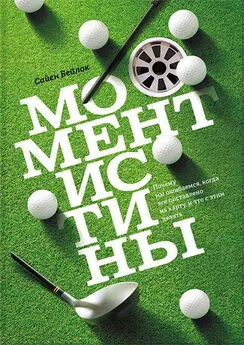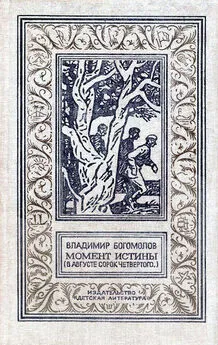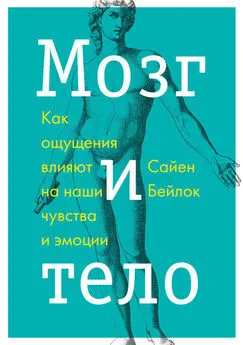Сайен Бейлок - Момент истины. Почему мы ошибаемся, когда все поставлено на карту, и что с этим делать?
- Название:Момент истины. Почему мы ошибаемся, когда все поставлено на карту, и что с этим делать?
- Автор:
- Жанр:
- Издательство:Манн, Иванов и Фербер
- Год:2015
- Город:Москва
- ISBN:978-5-00057-724-0
- Рейтинг:
- Избранное:Добавить в избранное
-
Отзывы:
-
Ваша оценка:
Сайен Бейлок - Момент истины. Почему мы ошибаемся, когда все поставлено на карту, и что с этим делать? краткое содержание
Момент истины. Почему мы ошибаемся, когда все поставлено на карту, и что с этим делать? - читать онлайн бесплатно полную версию (весь текст целиком)
Интервал:
Закладка:
29.© American Psychological Association, 2009. Использовано с разрешения с сокращениями: Maddux W. W., Galinsky A. D. Cultural borders and mental barriers: The relationship between living abroad and creativity // Journal of Personality and Social Psychology, 2009. Vol. 96. Pp. 1047–1061. Использование информации Американской ассоциации психологов не подразумевает поддержку данной работы Ассоциацией.
30.Дополнительно см. Thompson-Schill S. L., Ramscar M., Chrysikou E. G. Cognition without control: When a little frontal lobe goes a long way // Current Directions in Psychological Science, 2009. Vol. 18. Pp. 259–263. См. также: German T. P., Defeyter M. A. Immunity to functional fixedness in young children // Psychonomic Bulletin & Review, 2000. Vol. 7. Pp. 707–712.
31.Beilock S. L., DeCaro M. S. From poor performance to success under stress: Working memory, strategy selection, and mathematical problem solving under pressure // Journal of Experimental Psychology: Learning, Memory, & Cognition, 2007. Vol. 33. Pp. 983–998.
32.Conway A. R. A., Cowan N., Bunting M. F. The cocktail party phenomenon revisited: The importance of working memory capacity // Psychonomic Bulletin and Review, 2001. Vol. 8. Pp. 331–335.
33.Kersten A. W., Earles J. L. Less really is more for adults learning a miniature artificial language // Journal of Memory and Language, 2001. Vol. 44. Pp. 250–273. Дополнительно см.: Newport E. L. Maturational constraints on language learning // Cognitive Science, 1990. Vol. 14. Pp. 11–28.
34.Reverberi C., Toraldo A., D’Agostini S., Skrap M. Better without (lateral) frontal cortex? Insight problems solved by frontal patients // Brain, 2005. Vol. 128. Pp. 2882–2890.
35.Cochran B. P., McDonald J. L., Parault S. J. Too smart for their own good: The disadvantage of a superior processing capacity for adult language learners // Journal of Memory and Language, 1999. Vol. 41. Pp. 30–58.
36.Beilock S. L., Carr T. H., MacMahon C., Starkes J. L. When paying attention becomes counterproductive: Impact of divided versus skill-focused attention on novice and experienced performance of sensorimotor skills // Journal of Experimental Psychology: Applied, 2002. Vol. 8. Pp. 6–16.
37.Ellenbogen J. M., Hu P. T., Payne J. D. et al. Human relational memory requires time and sleep // Proceedings of the National Academy of Sciences, USA, 2007. Vol. 104. Pp. 7723–7728.
38.Friedman N. P. et al. Individual differences in executive functions are almost entirely genetic in origin // Journal of Experimental Psychology: General, 2008. Vol. 137. Pp. 201–225.
39.Ward J. The Student’s Guide to Cognitive Neuroscience, 2nd ed. London: Psychology Press, 2010.
40.Klingberg T., Forssberg H., Westerberg H. Training of working memory in children with ADHD // Journal of Clinical and Experimental Neuropsychology, 2002. Vol. 24. Pp. 781–791. См. также: Klingberg T. et al. Computerized training of working memory in children with ADHD — a randomized, controlled trial // Journal of the American Academy of Child Adolescent Psychiatry, 2005. Vol. 44. Pp. 177–186. Общий обзор см.: Клинберг Т. Перегруженный мозг. Информационный поток и пределы рабочей памяти. М. : Ломоносовъ, 2010.
41.Posner M. I., Rothbart M. K. Influencing brain networks: implications for education // Trends in Cognitive Sciences, 2005. Vol. 9. Pp. 99–103. Дополнительно см.: Rothbart M. K., Posner M. I. Educating the Human Brain. Washington, D.C.: American Psychological Association, 2006.
42.Olesen P. J., Westerberg H., Klingberg T. Increased prefrontal and parietal activity after training of working memory // Nature Neuroscience, 2003. Vol. 7. Pp. 75–79.
43.Green C. S., Bavelier D. Action video games modifies visual selective attention // Nature, 2003. Vol. 423. Pp. 534–537.
44.Gopher D., Weil M., Bareket T. Transfer of skill from a computer game trainer to flight // Human Factors, 1994Vol. 36. Pp. 1–19. См. также: Sharp Brains, интервью с Дэниелом Гофером, 2 ноября 2006 г. // http://www.sharpbrains.com/blog/2006/11/02/cognitive-simulations-for-basketball-game-intelligence-interview-with-prof-daniel-gopher/.
45.White H. A., Shah P. Uninhibited imaginations: Creativity in adults with Attention-Deficit/Hyperactivity Disorder // Personality and Individual Differences, 2006. Vol. 40. Pp. 1121–1131.
Глава 4
46.Summers L. H. Remarks at NBER Conference on Diversifying the Science & Engineering Workforce, Cambridge, Mass., January, 14, 2005.
47.Benbow C. P., Stanley J. C. Sex differences in mathematical reasoning ability: More facts // Science, 1983. Vol. 222. Pp. 1029–1030.
48.Ackerman P. L. Cognitive sex differences and mathematics and science achievement // American Psychologist, 2006. Vol. 61. Pp. 722–723.
49.Дополнительно см.: Shields S. A. Functionalism, Darwinism, and the psychology of women: A study in social myth // American Psychologist, 1975. Pp. 739–754.
50.Summers’ remarks on women draw fire // Boston Globe, 2005. January 17.
51.Herrnstain R., Murray C. The Bell Curve: Intelligence and Class Structure in American Life. New York: Free Press, 1994.
52.Benbow C. P., Stanley J. C. Sex differences in mathematical reasoning ability: More facts // Science, 1983. Vol. 222. Pp. 1029–1030. См. также: Benbow C. P., Stanley J. C. Sex differences in mathematical ability: Fact or artifact? // Science, 1980. Vol. 210. Pp. 1262–1264.
53.Ellison G., Swanson A. The gender gap in secondary school mathematics at high achievement levels: Evidence from the American Mathematics Competitions, NBER Working Paper No. 15238, August 2009.
54.Rivera S. M., Reiss A. L., Eckert M. A., Menon V. Developmental changes in mental arithmetic: Evidence for increased specialization in the left inferior parietal cortex // Cerebral Cortex, 2005. Vol. 15. Pp. 1779–1790.
55.Дополнительно см.: Halpern D. F. et al. The science of sex differences in science and mathematics // Psychological Science in the Public Interest, 2007. Vol. 8. Pp. 1–51.
56.Resnick S. M., Berenbaum S. A., Gottesman I. I., Bouchard T. J. Early hormonal influences on cognitive functioning in congenital adrenal hyperplasia // Developmental Psychology, 1986. Vol. 22. Pp. 191–198. См. также: Maloufa M. A. et al. Cognitive outcome in adult women affected by congenital adrenal hyperplasia due to 21-hydroxylase deficiency // Hormone Research in Pediatrics, 2006. Vol. 65. Pp. 142–150.
57.Monastersky R. Studies show biological differences in how boys and girls learn about math, but social factors play a big role too // Chronicle of Higher Education, 2005. March 4. Vol. 51.
58.Дополнительно см.: Spelke E. S. Sex differences in intrinsic aptitude for mathematics and science? A critical review // American Psychologist, 2005. Vol. 60. Pp. 950–958.
59.Gallagher A., DeLisi R. Gender differences in Scholastic Aptitude Test — Mathematics problem solving among high-ability students // Journal of Educational Psychology, 1994. Vol. 86. Pp. 204–211.
60.Fennema E., Carpenter T., Jacobs V. et al. A longitudinal study of gender differences in young children’s mathematical thinking // Educational Researcher, 1996. Vol. 27. Pp. 33–43.
61.Butler L. Gender differences in children’s arithmetical problem solving procedures. Unpublished M.A. thesis, University of California at Los Angeles, 1999 // Association for Women in Mathematics president Cathy Kessel’s talk at the MER-AWM Session at the 2005 Joint Mathematics Meetings.
62.Atkinson R. C. Let’s step back from the SAT I // San Jose Mercury News, 2001. February 23 // http://www.ucop.edu/pres/comments/satmerc.html.
63.Spencer S. J., Steele C. M., Quinn D. M. Stereotype threat and women’s math performance // Journal of Experimental Social Psychology, 1999. Vol. 35. Pp. 4–28.
64.Дополнительно см.: Steele C. M. A threat in the air: How stereotypes shape intellectual identity and performance // American Psychologist, 1997. Vol. 52. Pp. 613–629; Schmader T., Johns M., Forbes C. An integrated process model of stereotype threat effects on performance // Psychological Review, 2008. Vol. 115. Pp. 336–356.
65.Krendl A. C., Richeson J. A., Kelley W. M., Heatherton T. F. The negative consequences of threat: A functional magnetic resonance imaging investigation of the neural mechanisms underlying women’s underperformance in math // Psychological Science, 2008. Vol. 19. Pp. 168–175. См. также: Beilock S. L. Math performance in stressful situations // Current Directions in Psychological Science, 2008. Vol. 17. Pp. 339–343.
66.Levine S. C. et al. Socioeconomic status modifies the sex difference in spatial skill // Psychological Science, 2005. Vol. 16. Pp. 841–845.
67.Thurstone T. G. PMA readiness level. Chicago: Science Research Associates, 1974. Приведено с разрешения.
68.В 2001 г. 90% всех комплектов Lego, проданных в США, предназначались для мальчиков. См.: Mattel sees untapped market for blocks: Little girls // Wall Street Journal, 2002. June 6. Более того, как сообщала Wall Street Journal 24 декабря 2009 г., Lego практически отсутствуют на рынке игрушек для девочек: http://online.wsj.com/article/SB10001424052748704254604574613791179449708.html.
69.Hassett J. M., Siebert E. R., Wallen K. Sex differences in rhesus monkey toy preferences parallel those of children // Hormones & Behavior, 2008. Vol. 54. Pp. 359–364.
70.Wallen K. Hormonal influences on sexually differentiated behavior in nonhuman primates // Frontiers in Neuroendocrinology, 2005. Vol. 26. Pp. 7–26.
71.Connellan J. et al. Sex differences in human neonatal social perception // Infant Behavior & Development, 2000. Vol. 23. Pp. 113–118.
72.Дополнительно см.: Spelke E. S. Sex Differences in intrinsic aptitude for mathematics and science? A critical review // American Psychologist, 2005. Vol. 60. Pp. 950–958.
73.Guiso L., Monte F., Sapienza P., Zingales L. Culture, gender, and math // Science, 2008. Vol. 320. Pp. 1164–1165.
74.Mattel says it erred; Teen Talk Barbie turns silent on math // New York Times, 1992. October 21 // http://www.nytimes.com/1992/10/21/business/company-news-mattel-says-it-erred-teen-talk-barbie-turns-silent-on-math.html.
75.Figlio D. N. Why Barbie says ‘Math is Hard’ // Working Paper, University of Florida, December 2005.
76.Больше прочесть о гендерных различиях в привязке к именам можно здесь: Пинкер С. Субстанция мышления: язык как окно в человеческую природу. М. : КД Либроком, 2013.
Читать дальшеИнтервал:
Закладка:










